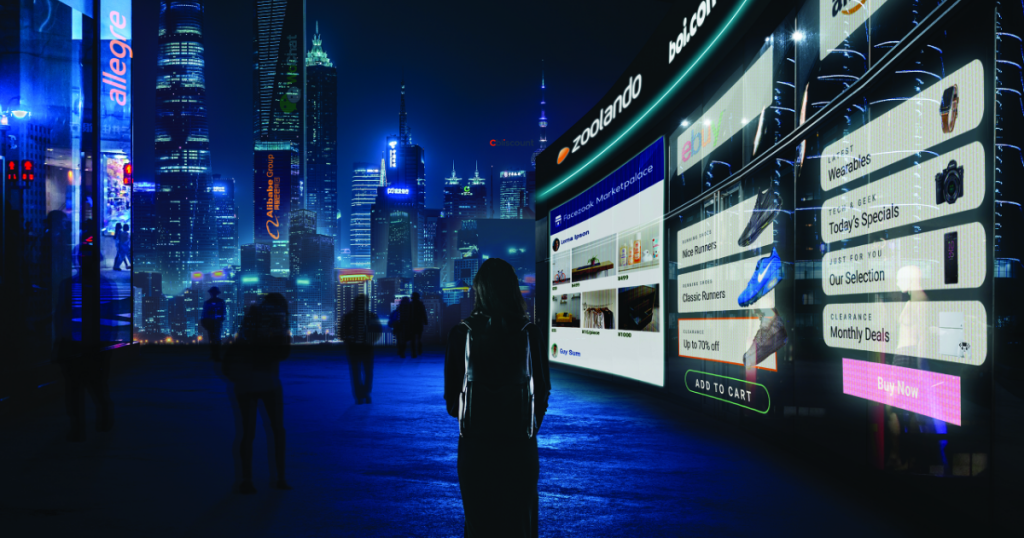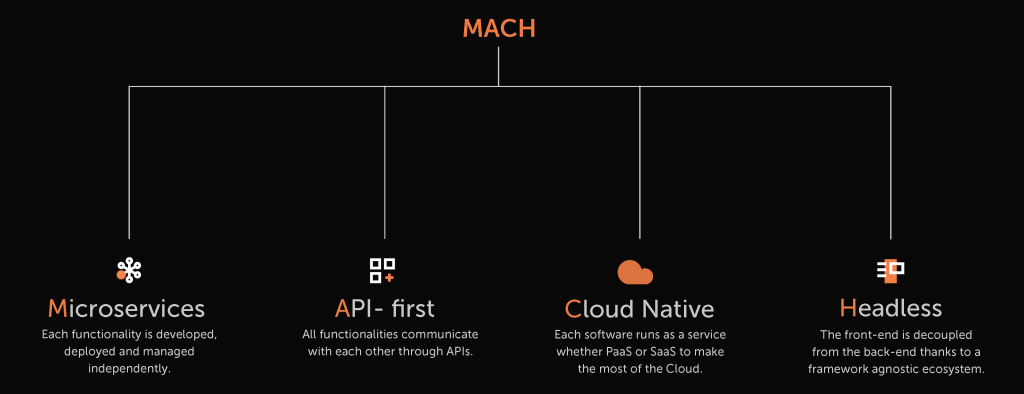The future of digital agencies is being negotiated at MACH speed

For many years, the number of APIs available in integrated experience platforms plus developments to decouple the functional core from user interfaces has dramatically increased. Composable solutions are now the focus, even among historical players. Yet, incumbents still have to overcome significant challenges to fully embrace architectures organised as micro-services that are API-led and provide composable headless solutions. As a result, a whole new generation of solutions has emerged, providing richer options for clients and our ability to support them.
Digital experience platforms: the new model
Over the last decade, applications used by brands for specific functional purposes (e.g., newsletter engines or web content management systems) have aimed for stronger integration to cater to the priorities of digital business. Single-purpose solutions such as content management systems, collaborative applications and CRM software have given way to digital experience platforms. They offer many different functionalities in integrated ‘suites’, providing users with branded experiences that were previously unattainable.
However, the future lies in loosely coupled and headless solutions. Loose coupling through micro-services and API-led architectures provides the best path for businesses and brands to evolve at MACH speed.
With maturity comes complexity
Software suites have been integrated gradually. Large publishers have taken over small, specialised software publishers. They’ve developed specific tools internally for generalist architectures. These integrated digital experience platforms (Digital eXperience Platforms, aka DXP) were created to end complicated integration, improve data sharing between tools and develop seamless automated synchronisation. They were aimed at fostering harmonious, efficient, and fast ecosystems that deliver unique user experiences.
These platforms have generally kept their promises, but things quickly got complicated behind the scenes. As more and more tools, especially external ones, were integrated into the DXP, it became difficult to maintain them and make them evolve. Agencies had to juggle different technologies to swiftly provide digital ecosystems that answer the needs and wants of their clients. And this, while business is being done faster and in more agile ways, thus making it necessary to pull off short turnaround times and continuous delivery of solutions and components.
The limits of digital centralisation
At a back-end level, experts’ and technicians’ tasks are hampered by redundant functions and data duplication. The weight of software has become heavier with high costs, which sometimes hinders the evolution of the user experience.
How can you make different tools work in complete harmony without integrating them? And this, without removing the necessary or indispensable functionalities to the digital transformation of customers?
The future lies in composable solutions
Our clients who are most advanced on their digital transformation journey agree that it’s necessary to think of digital solution architecture based on three main priorities: microservices, API-led infrastructures and cloud hosting, which lower infrastructure complexity.

This combination makes it possible to disconnect the functional core of the solutions from user interfaces, with access to the platform’s functionalities. But above all, an API-first architecture allows you to:
- Use the same content or functionality from different channels;
- Design business processes across solution boundaries in a seamless way;
- Change individual software solutions that were initially embedded into the solution architecture;
- Include pieces of legacy tech landscape the client may be operating with together with the digital layer that is typically operating at a different pace and concurrency;
- Exploit data across solutions in a more controlled way for the client.
We’re convinced that the future belongs to ecosystems made with a new generation of digital solutions that are compatible with each other, but perfectly independent. These ecosystems are following MACH principles:
- Microservices: each functionality is developed, deployed and managed independently;
- API-first: all functionalities communicate with each other through APIs;
- Cloud Native: each software runs as a service whether PaaS (Platform as a Service) or SaaS (Software as a Service). It makes the most of the cloud for hosting and data storage, but also to support elastic business growth, automatic updates, continuous delivery and availability across a range of physical locations through simple access to the Internet;
- Headless: the front-end is no longer depending on the back-end, in terms of programming language, channels or functional logic. Why is that? Because the ecosystem is ‘framework-agnostic’, and therefore fully compatible with different software infrastructures.
This approach is used by the agencies’ teams in all its markets, for both B2C and B2B customers. It’s generally associated with a higher level of digital maturity which implies greater digital needs and a more advanced way of managing digital investments. Indeed, MACH is generally more capital intensive than integrated solutions and shifts the balance of CapEx and OpEx in digital initiatives.
Simpler, better, faster, smaller
The solutions mentioned here allow the creation of turnkey ecosystems, precisely meeting customer needs. They are ‘built to change’ and therefore able to follow changes mandated by the business.
They also facilitate the addition of functionalities required by brands as they arise.
As each service is independently developed by specialists, the functionalities become more efficient, making the ecosystem more effective, quickly. Thanks to this, digital agencies are also less limited in the development and creativity of the solutions they offer to clients. Clients invest in something that stays with them, i.e., the integration pattern and how their processes are supported, instead of spending their money on licenses, subscriptions, and a whole bunch of things that, in the end, don’t belong to them.
Consumers benefit from services and functionalities that perfectly match their user journey, both IRL and digital. The flexibility offered by MACH solutions makes different vendor tools compatible: stock management, e-shop interface, or after-sales service. Brand experiences can now be built from the best tool available, for each functionality.
Suppliers and client partners can become part of the extended digital client network to achieve more efficient interactions or even to deliver required functionality to end users. Therefore, MACH solutions are an enabler for the network-connected businesses of our digital future.
Emakina in the MACH Alliance
In November 2021, Emakina joined the EPAM Systems family. This leading digital transformation services and product engineering company is an expert in large technology suites and MACH ecosystems. As a founding member of the MACH alliance, EPAM has a wealth of expertise in guiding organisations through their tech stack optimisation journey and adoption of the MACH ecosystem.
It doesn’t stop there. Among the publishers converted to MACH principles, many are new partners of Emakina who offer standalone solutions along with specialised MACH tools.
One example is commercetools, which created the MACH acronym and offers a headless Merchant Centre PIM tool in addition to its unified commerce platform. Other examples include:
- Akeneo (PIM)
- FluentCommerce (OMS)
- Amplience (CMS)
- Vue Storefront (e-commerce)
- contentful (CMS)
- Contentstack (CMS)
- Algolia (AI-powered search)
It is, of course, not a coincidence that more than fifteen of the new partnerships established by Emakina have been with publishers of tools based on MACH principles.
We are convinced that the very near future belongs to digital agencies that master this new technological philosophy. Only they will be able to offer their clients’ brands flexible, scalable and future-proof infrastructures.
The creativity, efficiency and customisation of potential solutions strengthen their clients’ digital businesses. They will meet the ever-increasing demands of users while saving more time and energy and limiting expenses. Users will benefit from brand experiences that are more complete, more personalised, more efficient and more useful than ever. As we know, happy users grow successful businesses.
Our recent blog posts
See all blogs-
How is AI’s synthetic data enhancing User Experience Research? Technology

-
Web3.AI Rising : How new technology can add value to your business

-
How generative AI helped us create an e-commerce app – with personalised content – in just 2 weeks Technology

-
Can you build a foodie app in 3 days using Generative AI? (Spoiler alert: yes!)

